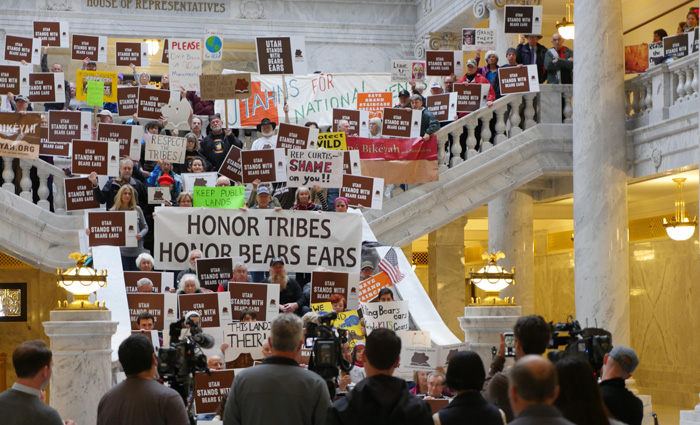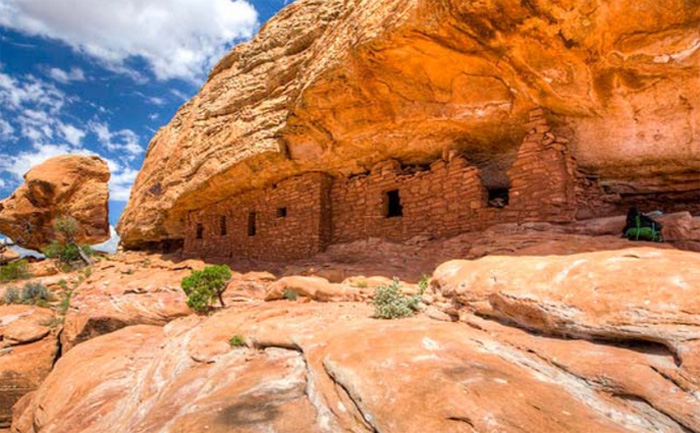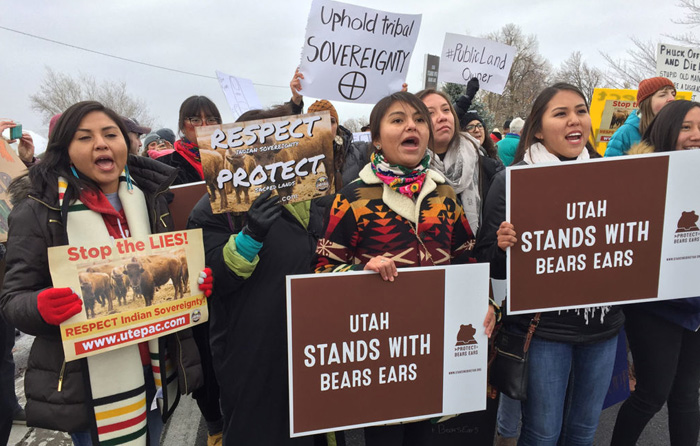
A hundred-plus Utahns gathered in the Rotunda at the Utah State Capitol on January 9 to demonstrate their support for Bears Ears National Monument and express unified opposition to a bill now before Congress that would replace Bears Ears with two smaller monuments. The rally was jointly organized by the Sierra Club, the indigenous activist group Utah Diné Bikéyah (UDB), and the Southern Utah Wilderness Alliance (SUWA).
The "Shash Jaa National Monument & Indian Creek National Monument Act" (H.R. 4532), introduced to the U.S. House of Representatives by Utah Rep. John Curtis, would replace Bears Ears—already proposed by President Trump to be radically downsized—with two tribally-managed national monuments that together total barely one-sixth the acreage of national monument created by President Obama.
H.R. 4532 ostensibly “protects historic and sacred tribal sites and significant archaeological areas” and gives Native Americans greater management authority over national monument lands. “Shash Jaa” is Navajo for “Bears Ears"—a transparent ploy to gain tribal support for the bill, which is viewed by Native American tribes as an affront.
“Rep. Curtis’s bill seeks to create a management scheme for the monument that would be dictated by parochial local interests against the interests of sovereign Tribal nations,” says Scott Groene, SUWA’s executive director.” It’s a brazen handout to the extremist voices who wish to eliminate federal public lands that belong to all. The fact that these bills even exist is evidence that the Utah delegation knows Trump’s actions were illegal, and they are scrambling to set up a Plan B.”

Dr. Garon Coriz, Kevin Madalena of Utah Diné Bikéyah, and Davis Filfred, Navajo Nation Council Delegate,at the 2017 Bears Ears Inter-Tribal Summer Gathering.
"H.R. 4532 ignores the wishes of five sovereign tribal nations, and opens the floodgate for fossil fuel extraction,” says Carly Ferro, and organizer with the Sierra Club’s Utah Chapter. “Utah has become ground zero for the attack on our public lands, but we’re confident that together with our tribal allies and local allies, we have a strong coalition that will overcome the obstacles ahead."
Braidan Weeks, Communications Coordinator for Utah Diné Bikéyah, recounts a recent conversation with a Ute elder. "She told me, 'to understand the land you have to understand our history. We have not always lived where we do now. Our relatives lived on that land down there and we used to live on that land when we visited them. We would hunt there and dance. That is our history too. How can they separate us from that?'
"Her concern is reflective of my own," Weeks says. "Native history doesn’t conform to today's arbitrary borders. All five tribes have familial and historic ties to the Bears Ears region. To deny this based only on current geography is a gross dismissal of our people in this sacred place."

Ancient Puebloan ruins in Bears Ears National Monument. Photo by Bob Wick / Bureau of Land Management, courtesy of Wikimedia Commons.
The January 9 rally was scheduled as a same-day response to H.R. 4532’s hearing in the House Committee on Natural Resources in Washington, D.C. Unsurprisingly, Utah congressman Rob Bishop, who chairs that committee, voiced his support for the H.R. 4532 on the grounds that it would open up more lands for multiple-use management—code for resource exploration and extraction—while giving tribes more power by allowing them to co-author the management plans for the two new national monuments.
The Rally in the Rotunda on Jan. 9 was the fourth time in just over a month that Utahns have flooded the state capitol to show support for Bears Ears and support the tribal coalition. More than 5,000 people rallied on December 2, another 2,000 demonstrated on December 4 (below), and over 100 showed up on December 12.

Activists at the December 4, 2017, rally in Salt Lake City. Photo by Terri Martin / SUWA.
"H.R. 4532 doubles down on President Trump's illegal attack on our national monuments by codifying the largest elimination of public lands protections in history,” says Utah Sierra Club director Ashley Soltysiak, below at lectern. “The bill is a thinly veiled attempt to auction these cultural, ecological, and archeological resources to special interests by codifying a rollback of over 1 million acres of the national monument. We are committed to supporting the tribal coalition and protecting the landscape from mineral exploitation."

Ashley Soltysiak, director of the Utah Sierra Club, addresses the crowd at the January 9 rally.
Ferro gives a shout-out to Utah Chapter volunteers Craig Provost and Peter Gatch, “who continue to show up and offer assistance at every event,” and to Lindsay Beebe of the Sierra Club’s Beyond Coal campaign for her help with the rallies.

Activist at the Rally Against Trump's Monumental Mistake on December 2, 2017. Photo by Jeff Clay | Clayhaus Photography
###
All photos by Carly Ferro, except where noted.